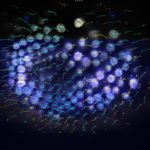Lien vers Pubmed [PMID] – 24045025
Lien DOI – 10.1016/j.ymeth.2013.09.005S1046-2023(13)00365-4
Methods 2014 Mar; 66(2): 353-61
Energy transfer mechanisms represent the basis for an array of valuable tools to infer interactions in vitro and in vivo, enhance detection or resolve interspecies distances such as with resonance. Based upon our own previously published studies and new results shown here we present a novel framework describing for the first time a model giving a view of the biophysical relationship between Fluorescence by Unbound Excitation from Luminescence (FUEL), a conventional radiative excitation-emission process, and bioluminescence resonance energy transfer. We show here that in homogeneous solutions and in fluorophore-targeted bacteria, FUEL is the dominant mechanism responsible for the production of red-shifted photons. The minor resonance contribution was ascertained by comparing the intensity of the experimental signal to its theoretical resonance counterpart. Distinctive features of the in vitro FUEL signal include a macroscopic depth dependency, a lack of enhancement upon targeting at a constant fluorophore concentration cf and a non-square dependency on cf. Significantly, FUEL is an important, so far overlooked, component of all resonance phenomena which should guide the design of appropriate controls when elucidating interactions. Last, our results highlight the potential for FUEL as a means to enhance in vivo and in vitro detection through complex media while alleviating the need for targeting.





